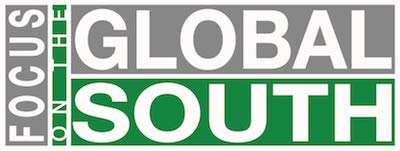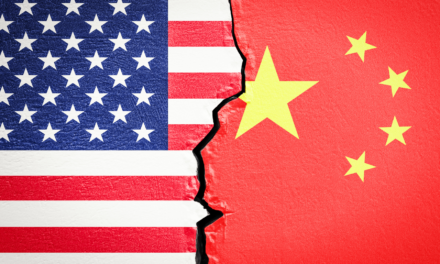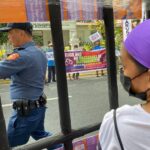By Walden Bello
(published originally in Peace Review 10:3 (1998), 367 – 373)
The hundredth anniversary of the United States’ bursting into the Asia – Pacific as an imperial power provides an opportunity to look more deeply at an imperialism that continues to be extremely dynamic. When the U.S. erupted into Asia, grabbing the Philippines from Spain in 1898, it was clear that this was not an old-style imperial power. The U.S. had itself emerged from an anti-colonial war against Great Britain a little over a century earlier, and this fact of its birth would greatly determine its ideology and practice of imperialism.
Ideology would play an important role in the U.S. imperial enterprise, far greater than it did with the European colonial powers where mission civilatrice, as in the case of France, was an afterthought, an obvious fig leaf for economic interests. Imperialism had to be legitimized to the American people. The emergence of the “Anti-Imperialist League” in the late 1800s – with which Samuel Clemens (Mark Twain) was associated – served as a warning that neither the rationale of christianizing the Catholic heathens of the Philippines articulated by President McKinley, nor that of Manifest Destiny promoted by Albert Beveridge would do.
Following the ruthless pacification of the Philippines, the U.S. establishment gradually settled on a justification of colonialism: the export of democracy and the preparation of the Filipino people for responsible independence. This was not simply propaganda. This justification brought the colonial enterprise into line with U.S. political values, thus preserving its legitimacy in the eyes of the American people. The idealist dimension to U.S. imperialism served to legitimize but also functioned as a source of tension and unpredictability. Indeed, U.S. imperialism developed into a complex phenomenon, where the cultural ideological dimension coexisted with two other relatively autonomous drives: the extension of the strategic reach of the U.S. state and the expansionist dynamic of U,S. economic interests.
Imperialism is often explained primarily as an outcome of economic expansionism. This is certainly the case in Latin America, where, for example, in the cases of United Fruit in Guatemala and International Telephone and Telegraph ITT in Chile, political and military initiatives were undertaken largely to support the interests of particular corporations and to create the political climate for the expansion of U.S. economic interests as a whole.
Asia was different. In Asia, U.S. strategic interests were paramount. In contrast to Latin America, commercial rationales were formulated to support the extension of the strategic reach of the U.S. state. This was true as far back as 1853, when Commodore Matthew Perry brought his ships to Tokyo Bay to open Japan up to commerce.
It was not unusual that a naval officer rather than a merchant forced Japan to open. In the U.S.’s century-long drive to the western Pacific, trade followed the flag more frequently than the flag followed trade. In 1898, when the U.S. made its 8,000 mile leap to the Philippines, less than 10% of U.S. trade crossed the Pacific, whereas 60% crossed the Atlantic. China, Korea, and Japan were sources of exotic imports rather than significant exports. Investments in the region were negligible. As Griswold said, “American capital for the exploitation of China [was] being raised with difficulty.”
What lay behind the great leap westward was not a business cabal but a strategic lobby of naval and political expansionists mainly interested in extending the reach of the U.S. state. Entrepreneurs operating in Hawaii, the Philippines, China and the interstices of the dominant European empires vociferously supported the expansion, but they did not constitute the center for U.S. business. That center was in New York and oriented far more towards Europe than Asia. The U.S. Navy became particularly adept at invoking a commercial rationale to promote U.S. strategic extension, and its own role as the cutting edge of that mission. Acquiring bases in the far reaches of the Pacific would, among other things, provide a powerful impetus to the creation of the “two-ocean navy.” The two-ocean navy was considered necessary to achieve the goal of maritime supremacy envisioned by the fleet’s leading strategic thinker, Captain Alfred Mahan.
Led by the influential Mahan and Assistant Secretary of the Navy Theodore Roosevelt, the U.S. Navy was the main force behind the acquisition of Hawaii, Guam, and the Philippines on the heels of Admiral George Dewey’s victory over the Spanish squadron in Manila Bay in May 1898. The small island of Guam in the Marianas and the Philippine archipelago were depicted as stepping stones to the riches of China but only to justify their annexation in the face of significant domestic opposition. Washington’s main desire was the projection of U.S. power. Guam’s and the Philippines’ geographic position were strategic for this purpose. Hawaii had been under the control of American planters for over a decade, but it was not until the Spanish – American War of 1898 that its strategic importance was fully appreciated. During the war, the naval base at Pearl Harbor was instrumental in projecting U.S. naval power to the western Pacific; following the war, moves were made to annex Hawaii.
Ironically, the Navy’s thinking was most succinctly captured by an Army man, General Arthur MacArthur, father of the more famous Douglas. Chief of the colonizing army that subjugated the country, MacArthur described the Philippines as
the finest group of islands in the world. Its strategic location is unexcelled by any other position in the globe. The China Sea, which separates it by something like 750 miles from the continent, is nothing more nor less than a safety moat. It lies on the flank of what might be called several thousand miles of coastline; it is the center of that position. It is therefore relatively better placed than Japan, which is on a flank, and therefore remote from the other extremity; likewise India, on another flank. It affords a means of protecting American interests which with the very least output of physical power has the effect of a commanding position in itself to retard hostile action.
So important was a western Pacific presence for the institutional expansion of the Navy that when key Army officials favored withdrawal from the region in the 1930s, arguing that the Philippines and other Pacific U.S. possessions had become a strategic liability in the face of Japan’s growing might, the Navy blocked any consideration of leaving. This set the stage for the U.S. defeats in the early days of the Second World War.
Projection of strategic power continued to be the central impetus behind U.S. policy in the Asia – Pacific after the Second World War. “Forward Defense” and “Containment of Communism” were the articulated rationales, but the imperative was strategic extension of the power of the U.S. state. Just as his father had most succinctly expressed the Navy’s rationale for acquiring the Philippines, it fell to Army General Douglas MacArthur to express most cogently and candidly the U.S. military’s strategic imperative in post-war Asia: “The strategic boundaries of the U.S. were no longer along the western shore of North and South America; they lay along the eastern coast of the Asiatic continent.”
Projecting U.S. strategic power necessitated the creation of a network of more than 300 bases on the territory of seven Asia – Pacific countries. In reality, this military network formed an autonomous transnational garrison state. Power projection was the principal determinant of U.S. military interventions in Korea and in Vietnam, though, of course, ideological considerations – stopping the spread of communism – also played a role. In this regard, ideology was the handmaiden of strategic realpolitik, a point underlined by George Kennan’s containment strategy itself, which saw the Soviet Union’s eastward and westward thrusts as the threat to be neutralized, not messianic communism.
Pentagon officials hastily cooked up rationales about the importance of Southeast Asia’s raw materials, but, in reality, corporate interests hardly played a role in either Korea or Vietnam. The strategic and political priorities were underlined by the fact that the U.S. government turned the other way and allowed Japan and other East Asian countries to follow policies of protectionism, investment discrimination, and strong state support for local business during the Cold War period. These policies severely disadvantaged U.S. corporations and U.S. traders, but Washington judged these costs to be worth the strategic political and military alliance it was able to extract as a quid pro qua from the Asian elites. It was only when the Cold War began to wind down, during the Reagan presidency, that corporate and trade interests began to dominate the U.S. agenda for the region. Pressures for this shift had, of course, been building for years; pressures based on the growing and accurate – perception of both U.S. corporate executives and trade officials that the prosperity of Japan and the so-called “newly industrializing countries” (NICs) had been purchased at the expense of U.S. interests. It was only in the late 1980s, with the waning of the strategic threat, that the Washington elite allowed U.S. policy to move from political alliance to aggressive trade war.
But whether pushed principally by strategic motives, as in Asia, or by corporate interests, as in Latin America, U.S. imperialism has always been accompanied by a strong streak of missionary idealism. It was an idealism born out of the U.S.’s own origins as an anti-colonial country with a democratic ideology. Anti-colonialism and democracy thus coexisted in often sharp tension with the strategic and economic imperatives of U.S. imperialism.
The annexation of the Philippines exemplified the American dilemma. The solution was also classically American: the wholesale export of the institutions of U.S. democracy to the Philippines. This functioned successfully to build consensus about imperial expansionism among both Americans and Filipinos. A wholesale transplant of formal political institutions began shortly after the conquest. U.S. colonial authorities and missionaries served as instructors; the Philippine elite playing the role of student. By the time of independence in 1946, the Philippine political system was a mirror image of the American, with its presidential leadership, separation of powers, two-party system, and its Lockean emphasis on private property as the foundation of liberty.
In the actual exercise of power, the Philippine democratic system was a marriage between the feudal paternalism of the Philippine elite and the Chicago-style machine politics of the 1920s. Electoral politics was enthusiastically embraced by the regional landed elites; landed elites that the U.S. had successfully detached from the Philippine anti-colonial struggle and formed into a national ruling class. But it was hardly a belief in representative democracy that made them eager students. Their eagerness grew because democratic elections provided a means for that fractious class to compete, relatively peacefully, for political office and alternating turns in power. For the poor majority of Filipinos, elections afforded the illusion of democratic choice – that is, the ability to choose among different elite candidates and elite political parties. Democracy did not extend to the economic sphere. The play of electoral politics unfolded above an immobile class structure, in a country where income distribution was among the worst in Asia.
The U.S. created the local elite, tied that elite to the U.S. economy by providing access to the U.S. market for its agricultural products, and socialized both the elite and the population at large to formal democratic practices. After all that, the U.S. felt confident that formal independence would not result in an unfriendly country.
With the onset of the Cold War, this Philippine paradigm guided the U.S.’s approach to other countries in the region. The Cold War reproduced on a global scale the contradiction that the U.S. experienced fifty years earlier when it annexed the Philippines – the conflict between America’s disdain for colonialism and its desire for real control. “The U.S.,” Neil Sheehan has pointed out, “did not seek colonies as such.”
Having overt colonies was not acceptable to the American political conscience. Americans were convinced that their imperial system did not victimize foreign peoples … It was thought to be neither exploitative, like the nineteenth-century-style colonialism of the European empires, nor destructive of personal freedom and other worthy human values, like the totalitarianism of the Soviet Union and China and their Communist allies. Instead of formal colonies, the United States sought local governments amenable to American wishes and, where possible, subject to indirect control from behind the scenes. Washington wanted native regimes that would act as surrogates for American power. The goal was to achieve the sway over allies and dependencies which every imperial nation needs to work its will in world affairs without the structure of old-fashioned colonialism.
And, as in the case of the Philippines, formal democracies controlled by U.S.-allied elites provided both the mechanism of influence and the justification for intervention in Third World countries. As Frances Fitzgerald pointed out in her classic book Fire in the Lake,
The idea that the mission of the United States was to build democracy around the world had become a convention of American politics in the 1950’s, Among certain circles, it was more or less assumed that democracy, that is, electoral democracy combined with private ownership and civil liberties, was what the United States had to offer the Third World. Democracy provided not only the basis for American opposition to Communism but the practical method to make sure that opposition worked.
In both Korea and Vietnam, U.S. officials tried to set up representative democracies as the best antidote to communism. They overlooked that they were working through reactionary elites who did not believe in democracy in the first place. The CIA officer Edward Lansdale, for instance, saw the feudal patriarch Ngo Dinh Diem as a reformist democrat in the mold of Ramon Magsaysay. Lansdale, with Magsaysay’s collaboration, had crushed the communist insurgency in the Philippines in the early 1950s. But neither Vietnam nor Korea was the Philippines, where the elite had been socialized by the U.S. colonial authorities over a fifty-year period. The Korean and Vietnamese ruling groups had collaborated with despotic colonial powers – Japan in the case of Korea, France in the case of Vietnam. In these two intensely nationalistic countries, the Americans were perceived as stepping into the shoes of the old colonialists. Their “democratic” clients – Rhee Syng-Man in Korea, Ngo Dinh Diem in Vietnam – were mocked as reactionaries masquerading as democrats.
Many U.S. officials became disenchanted with the ideology of missionary democracy given its failure to stabilize Asian societies caught up in nationalist revolution by implanting formal democratic regimes. The key criterion for choosing allies became their anti-communist, not democratic, credentials. The change was justified largely by invoking strategic security. This shift culminated in the firm, unstinting support the U.S. gave to strongman regimes, prominently Park Chung-Hee in Korea (1962 – 1979), Marcos in the Philippines (1965 – 1986), and Suharto in Indonesia (1965 – 1998).
The imperial enterprise, however, continued to need an ideological rationale consistent with the values of the U.S. system of governance to sustain popular support within the U.S. Alternatives to “budding democracy” failed dramatically. When the Vietnam adventure was explained mainly as an effort to save an ally or to secure “peace with honor,” the war was lost. In the 1970s and 1980s, all attempts to formulate substitute rationales failed to secure support for U.S. policy: whether this was Henry Kissinger’s invocation of European-style raison d’etat, Samuel Huntington’s and Jeanne Kirkpatrick’s glorification of authoritarian rule, or Ronald Reagan’s and George Bush’s crass redefinition of murderers, military dictators, and autocrats as democratic allies.
Henry Kissinger’s Central European conceptualization of U.S. relations with the Third World was captured in his classic statement on Salvador Allende’s presidency in Chile: “I don’t see why we should let a country go Marxist because its people are irresponsible.” Samuel P. Huntington’s 1968 book Political Order in Changing Societies played an influential role in turning U.S. officials in the Third World from a focus on supporting democratic structures to an emphasis on building “structures of authority.” Jeanne Kirkpatrick’s essay “Dictatorship and Double Standards,” in Commentary, July 1979, explicitly argued for support of authoritarian regimes in the Third World to prevent political disorder. Vice President George Bush’s Orwellian toast to Marcos during a visit to Manila in 1981 possibly represented the ideological nadir of this stage of U.S. imperial policy: “We love you, sir … We love your adherence to democratic rights and processes.”
The wave of democratization that did sweep the Third World and East Asia starting in the mid-1980s took place in spite of, rather than because of, U.S. policy. During the years of Republican ascendancy, many Democrats warned that to jettison the promotion of democracy as a key component of U.S. foreign policy only to concentrate on strategic and economic interests would be self-defeating in the long run. The U.S.’s role as the world’s hegemonic power was precisely legitimized by its democratic ideology and political practice. The warnings were validated by the emergence of anti-dictatorship movements in which the left was centrals trend exemplified by the Philippines, where the left-wing National Democratic Front gained significant allies among elites opposing Marcos. With the assassination of Filipino opposition leader Benigno Aquino in 1983, pragmatists in the U.S. State Department moved from uncritical support of Marcos towards favoring a democratic opening. In the end Washington carted Marcos off to Honolulu during the civil – military uprising in February 1986 and threw its full backing to Corazon Aquino.
Pragmatists in the Reagan administration also pressed the Chun dictatorship to step down during the 1987 uprising in Korea and threw Washington’s weight behind free elections. In Latin America, Africa, and Eastern Europe, the pragmatists likewise sought to maintain U.S. influence by pressing for elections, as they did in Chile, where Pinochet yielded to a democratically elected government in 1990.
What was pragmatic adjustment during the Reagan and Bush administrations became a central ideological tenet to the first Clinton administration. Missionary democracy was once more ensconced as a primary drive of U.S. foreign policy. Promoting democracy was the main rationale for sending U.S, troops to Haiti and imposing sanctions on Burma. Two problematic areas arose – Indonesia and China. These two areas can serve to illustrate the tension among the strategic, economic, and ideological drives of U.S. imperialism. These cases also show the relatively autonomous role of specific administrations in shaping the thrust of policy at certain conjunctures.
In the case of Indonesia, the perception that the long-time U.S. ally Suharto was the irreplaceable linchpin of U.S. security interests prevented the Clinton administration from pressing the dictator for democratic reforms – at least not until the massive urban riots in Jakarta in late May 1998 forced Washington to nudge Suharto to leave office.
The case of China was more complex. U.S. corporations, seeking to exploit what they considered the mass market of the 21st century, lobbied the Clinton administration to tone down U.S. criticism of China’s record on human rights and democracy. On the other hand, the U.S. defense establishment, convinced that China would be the U.S.’s most formidable strategic rival, had set in motion a policy of containment. To keep China off balance, it tactically allied with the human rights and pro-democracy lobby to heighten criticism of China. The different driving forces of U.S. imperialism were out of synch. Given this, the Clinton administration’s role in determining the thrust of U.S. policy tipped the balance. It chose to stabilize U.S.– China relations along the lines that U.S. business interests preferred.
Economic expansion, strategic extension, and missionary democracy are the three main driving forces of the U.S. imperialist enterprise that made its dramatic entrance in 1898. These three drives have coexisted uneasily as relatively autonomous imperatives. The history of U.S. foreign policy toward different regions of the Third World reflects attempts of various administrations to work out compromises or unstable equilibria among these drives. It is significant that each administration enjoyed a great degree of autonomy in working out policies for each conjuncture. There: is, in fact, a strong element of truth in the description “the imperial presidency.”
The Philippines, where the U.S. set up military bases to project power onto the Asian mainland and where U.S. corporations took over key sectors of the economy, became the laboratory for forging an imperial formula, especially on the ideological front. In a very real sense, the problematique of U,S. policy since World War II has been how to reproduce the Philippine formula in the rest of the Third World, particularly in Asia.








